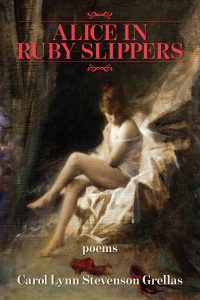Featured poem issue #57
How To Fall in Love with Robert Bly
Semifinalists: Carol Lynn Grellas
2023Northern Cal Book Award nomination for Epitaph for the Beloved
2020Shortlisted for the Eric Hoffer Award Grand Prize, along with Honorable Mention in Poetry Alice in Ruby Slippers
2021Nomination for the AWP Intro Journals Project Poetry
2021Poetry Finalist
2021Water Goddess
2020Eight in the Morning
James Joyce Nora Have a Heart to Heart in Heaven
A Mall in California
2018In the Making of Goodbyes
2019An Ode to Hope in the Midst of Pandemonium
2018BEFORE I GO TO SLEEP
2012
I’m a fan of poetic forms. Haiku. Sonnet. Pantoum. The elusive sestina. I think there is something magical that happens when a poet jumps into a scaffolding. The scaffolding lifts us, readers and author, to unique connections and dramatic conclusions. Which makes Alice in Ruby Slippers, a collection of poems by Carol Lynn Stevenson Grellas, an unexpected adventure. The mixing of tales in its titles signifies we’re going on a journey of what we think – on entirely new and independent paths, devised by Grellas, just as she’s modifying the poetic forms to suit her voice and her plan for her poems. Lured by the promise of familiar sonnets and other poems, I’m granted entry into a world of Grellas’ imagination.
What are the elements that make this journey wild and wonderful? Let’s talk about rhyming. Rhyme is a traditional component of many poetic forms. What makes rhyme special, I think, is the expected connections and clever use of language as well as the emphasis on the sound of your poem. In her poem, “Without Vision,” she writes: “a secret illness writes itself in Braille / soundless as the unseen breath of trees, / it lives, grows, sighs and breathes within / the shadow of the body’s fleshy veil” (73). These lines are jammed with exciting rhyme. The end-rhymes, the middle of the line rhymes. My favorite is the hardworking rhyme of trees/breathes which replicates the soft sighs immediately preceding it. The rhyme that works like this embeds the reader in the experience of the poem.
Grellas makes sound a foundation of her poems. In “On Underestimating the Aftermath,” Grellas writes about a daughter caring for dying parents. Despite the daughter’s hard work and knowledgeable caretaking, the grief and loss are profound. “But when dying was over, their eulogy read … / there was no one to tell me, good girl. They were dead,” (71). In the repetition of single syllables and the final simple three words, Grellas draw out the experience of a huge loss and finality of that singular loss. In “Since You’ve been Gone,” sound is the central component of the poem itself. Whether it's music that reminds the narrator of the passed person or how they “play / old messages to hear your voice again –“ (19) Grellas reminds us the sound evokes emotions and deftly wields sound to guide us through her poetic constructions.
Grellas also uses sound and rhyme and rhythm to reveal the speechless, soundless, almost sacred moments in life. In “The Cancer Diagnosis” a couple waits for information and Grellas documents the time “when nothing said conveys all thoughts repressed,” (24). Or in “The Sequoia,” Grellas writes about a moment of transcendence in the landscape, “through bars of golden beams across the sod, / she disappeared forever on the day / communion with a tree brought her to God” (46). The rhyme of sod and God spans the same space of the sacred communion that can make one disappears. Grellas’ words hold the space that sound cannot truly describe.
In the end Grellas challenges us to do what she does throughout Alice in Ruby Slippers – to do “Six Impossible Things after Reading Alice.” The last of which is a question that Grellas has tried to answer and hands to the reader for their thoughts. “I’d like to know why lives collide – name Love our home, none left denied” (80). After traveling through Grellas structured poems and remade foundations, I’m certainly willing to try – will you be too? I strongly recommend reading this rich book aloud so you too can reveal the sounds – and silences – evoked in Grellas beautiful lines.